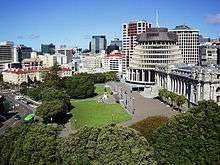William Clayton (architect)

William Henry Clayton (17 November 1823 – 23 August 1877) was a New Zealand colonial architect.
Early life
Born in Norfolk Plains, Australia, Clayton trained as an architect in England, and designed more than three hundred buildings in Tasmania, most notably Launceston's St Andrew's Kirk in 1849 before emigrating to New Zealand in 1863.
New Zealand career

He established the practice of Mason and Clayton with William Mason (later first mayor of Dunedin), and over six years designed many prominent buildings in the area, such as Dunedin's All Saints' Church and Edinburgh House.
In 1869 Clayton moved to Wellington to take up a post as the first (and only) Colonial Architect, in which position he became central to the public works projects of prime minister Julius Vogel (Clayton's daughter Mary had married Vogel in 1867). He designed many public buildings in Wellington, including the old Government House and Parliament buildings, but he is best known for designing the Old Government Buildings in Wellington, then part of the New Zealand Parliament Buildings and the second-largest wooden building in the world (behind Tōdai-ji in Nara, Japan). He also designed All Saints Church, Dunedin.[1] An important design in Christchurch is the Chief Post Office in Cathedral Square, a Category I heritage building.[2]
Clayton's self-designed residence, finished in 1874, was the first concrete house in New Zealand and the first house to have hot and cold running water (it is now a part of Queen Margaret College).
Death

Clayton died of an infected ankle on 23 August 1877, and was buried in Dunedin Northern Cemetery.
References
- ↑ Crighton, Anna. "Clayton, William Henry - Biography". Dictionary of New Zealand Biography. Ministry for Culture and Heritage. Retrieved 4 April 2011.
- ↑ "Chief Post Office (Former)". Register of Historic Places. Heritage New Zealand.
External links
-
 Media related to William Clayton (architect) at Wikimedia Commons
Media related to William Clayton (architect) at Wikimedia Commons
|